Peru Discovery - Conclusion
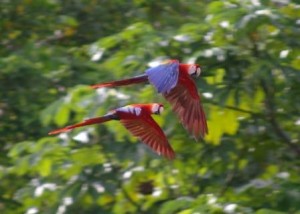 We awoke at four o’clock to a very light rain and are hopeful that it will not be too much to keep the parrots from descending upon the clay lick this morning. After a short boat ride up river to a sand bar, we hiked to research blinds located a hundred meters or so from the clay lick and settled in to wait for the parrots to arrive. Almost immediately we observe plenty of activity in the tree tops but it seems a bit wet on the clay lick for the birds to descend. Finally, a number of large macaws take the plunge and alight on the bank across the river.
We awoke at four o’clock to a very light rain and are hopeful that it will not be too much to keep the parrots from descending upon the clay lick this morning. After a short boat ride up river to a sand bar, we hiked to research blinds located a hundred meters or so from the clay lick and settled in to wait for the parrots to arrive. Almost immediately we observe plenty of activity in the tree tops but it seems a bit wet on the clay lick for the birds to descend. Finally, a number of large macaws take the plunge and alight on the bank across the river. 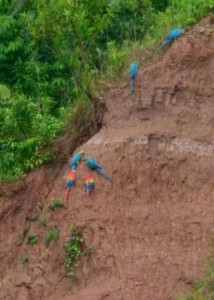 There are several theories as to why parrots (and many other animals) regularly visit these clay embankments, but currently it is thought that the clay provides nutrients – especially sodium – that are lacking in most of the vegetation the animals feed on. We were able to observe several species on the clay lick and while it wasn’t exactly the jaw-dropping experience we may have been hoping for, it was still impressive and an opportunity to admire what most people will never have the opportunity to see. Macaw conservation is an important focus of the Tambopata Research Center (TRC) and was one of the organizations initial conservation efforts. Macaws face many threats including habitat destruction for agriculture, selective logging of large trees the birds use for nesting, road construction and illegal collection for the pet trade. Sadly, nearly 85% of young macaws poached from the wild die – another reason to only purchase any pet from a responsible and caring breeder.
There are several theories as to why parrots (and many other animals) regularly visit these clay embankments, but currently it is thought that the clay provides nutrients – especially sodium – that are lacking in most of the vegetation the animals feed on. We were able to observe several species on the clay lick and while it wasn’t exactly the jaw-dropping experience we may have been hoping for, it was still impressive and an opportunity to admire what most people will never have the opportunity to see. Macaw conservation is an important focus of the Tambopata Research Center (TRC) and was one of the organizations initial conservation efforts. Macaws face many threats including habitat destruction for agriculture, selective logging of large trees the birds use for nesting, road construction and illegal collection for the pet trade. Sadly, nearly 85% of young macaws poached from the wild die – another reason to only purchase any pet from a responsible and caring breeder. 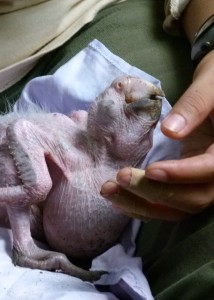 To compensate for lost nesting sites, the TRC has positioned nesting boxes throughout the area and monitors the macaw parents and chicks that use these nest boxes. Data is collected on adult behavior, chick growth and survival, migration patterns and many other details. While most of the research is conducted on the Scarlet Macaw, methods and results are often useful when working with other macaw species, many of which are severely threatened. Our morning at the clay lick may not have been a five star experience but the opportunity to witness researchers collecting data on macaw chicks more than made up for any disappointment. Another trip highlight was our visit to the medicinal garden of a community shaman named Onorato. Onorato created his gardens to treat low income residents of the area using traditional and natural treatments obtained from plant material obtained from the surrounding jungle. His garden included plants used for the treatment of everything from coughs and fevers to snake bites and cancer. There must be some credibility to these treatments – a German pharmaceutical company has confirmed curative properties and has patented plants from the South American jungles including materials used by Onorato.
To compensate for lost nesting sites, the TRC has positioned nesting boxes throughout the area and monitors the macaw parents and chicks that use these nest boxes. Data is collected on adult behavior, chick growth and survival, migration patterns and many other details. While most of the research is conducted on the Scarlet Macaw, methods and results are often useful when working with other macaw species, many of which are severely threatened. Our morning at the clay lick may not have been a five star experience but the opportunity to witness researchers collecting data on macaw chicks more than made up for any disappointment. Another trip highlight was our visit to the medicinal garden of a community shaman named Onorato. Onorato created his gardens to treat low income residents of the area using traditional and natural treatments obtained from plant material obtained from the surrounding jungle. His garden included plants used for the treatment of everything from coughs and fevers to snake bites and cancer. There must be some credibility to these treatments – a German pharmaceutical company has confirmed curative properties and has patented plants from the South American jungles including materials used by Onorato. 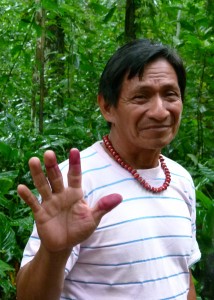 Our scaled-down group of Peru adventurers had many opportunities to hike and explore the surrounding jungles but we only scratched the surface of all there is to see. I return trip just may be in order. After nearly two weeks of travel, it is time to pack our bags and return to Colorado. Despite plenty of rain, early (and I mean early!!!) wake up calls and plenty of exhausting hikes, the trip has been an amazing experience. I am especially grateful for the adventurous group of trip participants who were eager to dive into every experience and who took any bumps in the road (or river) in stride and lived each moment of the trip to the fullest. Not only have I witnessed many incredible natural wonders, I’ve also met new people and made new friends. It doesn’t get much better than that!
Our scaled-down group of Peru adventurers had many opportunities to hike and explore the surrounding jungles but we only scratched the surface of all there is to see. I return trip just may be in order. After nearly two weeks of travel, it is time to pack our bags and return to Colorado. Despite plenty of rain, early (and I mean early!!!) wake up calls and plenty of exhausting hikes, the trip has been an amazing experience. I am especially grateful for the adventurous group of trip participants who were eager to dive into every experience and who took any bumps in the road (or river) in stride and lived each moment of the trip to the fullest. Not only have I witnessed many incredible natural wonders, I’ve also met new people and made new friends. It doesn’t get much better than that! 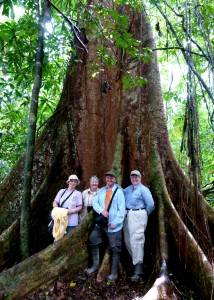
Add new comment